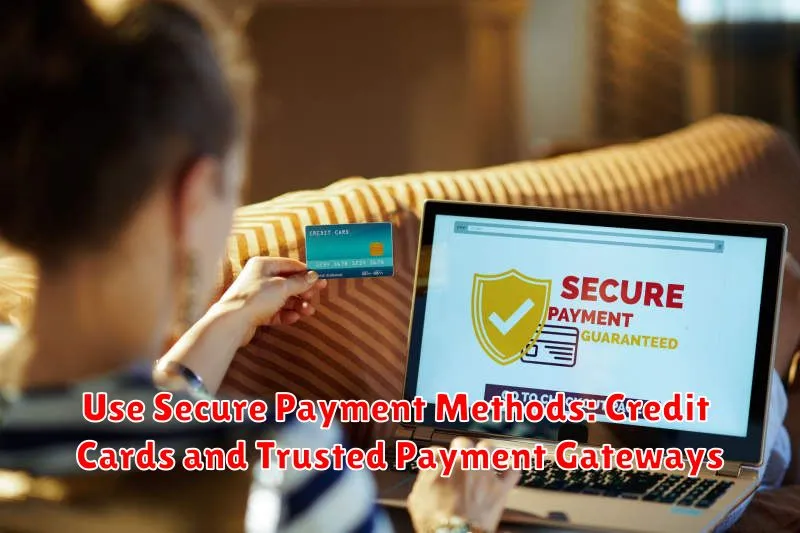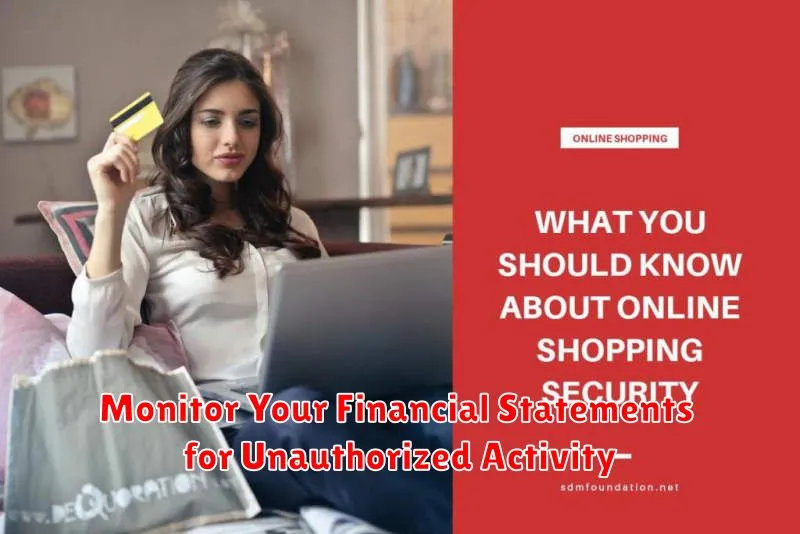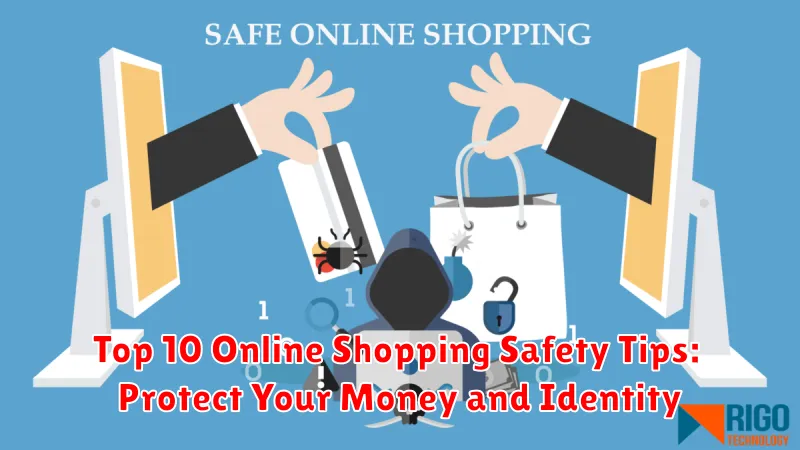Online shopping offers incredible convenience, allowing us to purchase virtually anything from the comfort of our homes. However, this convenience comes with inherent risks to both your financial security and personal information. It’s crucial to prioritize online shopping safety to protect yourself from potential scams, fraud, and identity theft. By following essential safety tips, you can confidently enjoy the benefits of online shopping while minimizing the risks. This article will outline the top ten online shopping safety tips to help you protect your money and identity while shopping online.
Protecting yourself while shopping online requires vigilance and proactive measures. From verifying website security to using strong passwords and practicing safe payment methods, understanding the potential risks and implementing these online shopping safety tips is paramount. By taking these precautions, you can significantly reduce the likelihood of becoming a victim of online shopping scams and ensure a safe and enjoyable online shopping experience. Protect your money and identity by learning and applying these ten essential safety tips.
Secure Your Accounts with Strong Passwords and Two-Factor Authentication
Protecting your online shopping accounts starts with strong passwords. Avoid easily guessable passwords like “password123” or your birthdate. Instead, create strong, unique passwords for each account using a combination of uppercase and lowercase letters, numbers, and symbols.
A good practice is to use a password manager. These tools generate and securely store complex passwords, eliminating the need to remember them all.
Enable two-factor authentication (2FA) whenever possible. 2FA adds an extra layer of security by requiring a second verification method, such as a code sent to your phone or email, in addition to your password. This makes it significantly harder for unauthorized individuals to access your accounts, even if they have your password.
By implementing these security measures, you create a strong defense against unauthorized access and protect your sensitive information.
Shop from Reputable Websites: Look for Secure Connections
When shopping online, stick to well-known and reputable websites. Established retailers generally have robust security measures in place to protect your information. If you’re unsure about a website’s legitimacy, research it online. Look for reviews and feedback from other customers.
Before entering any personal or financial information, always check for a secure connection. Look for “https” in the website address and a padlock icon in the address bar. The “s” in “https” stands for secure, indicating that the website uses encryption to protect your data during transmission.
Be wary of websites with unusual domain names or misspelled words. These can be signs of fraudulent websites attempting to mimic legitimate ones. Exercise caution when encountering unfamiliar online retailers.
Beware of Phishing Scams: Don’t Click on Suspicious Links
Phishing scams are a serious threat to online shoppers. These scams attempt to trick you into revealing personal information like your username, password, and credit card details.
Never click on links in unsolicited emails or text messages, especially those that ask for personal information. These links can lead to fake websites that look identical to legitimate online stores, but are designed to steal your information. Always navigate directly to a website by typing its address into your browser.
Be wary of emails or texts that create a sense of urgency, claiming your account has been compromised or that you need to act immediately to claim a prize. Legitimate companies rarely use these tactics.
Carefully inspect the sender’s email address. Phishing emails often use addresses that are similar but not identical to the legitimate company’s address. Look for misspellings or unusual characters.
If you’re unsure about a link’s legitimacy, hover your mouse over it (without clicking) to see the actual URL it leads to. If it looks suspicious, don’t click.
Use Secure Payment Methods: Credit Cards and Trusted Payment Gateways

When paying for online purchases, prioritize secure payment methods. Credit cards offer better fraud protection than debit cards. If fraudulent charges occur, your liability is typically limited. Many credit cards also provide purchase protection and extended warranties.
Look for trusted payment gateways like PayPal, Apple Pay, or Google Pay. These services add an extra layer of security by tokenizing your payment information. This means the merchant never receives your actual credit card details, reducing the risk of data breaches.
Avoid using wire transfers or prepaid gift cards for online purchases. These methods offer little to no recourse if something goes wrong. They are often preferred by scammers for this very reason.
Always double-check the payment page URL. Ensure it starts with “https” and that a padlock icon is present. This indicates a secure connection and encrypts your payment information.
Check Website Reviews and Ratings Before Making a Purchase
Before committing to a purchase, especially from a lesser-known online store, take the time to investigate its reputation. Customer reviews and ratings offer valuable insights into other shoppers’ experiences. Look for trends in feedback. A few negative reviews amidst many positive ones are normal, but a consistent pattern of complaints about shipping, customer service, or product quality should raise a red flag.
Seek out reviews on independent review platforms, not just those hosted on the website itself. These platforms often provide a more balanced perspective. Pay attention to the specificity of the reviews. Detailed accounts of positive or negative experiences are generally more trustworthy than vague comments.
Check the website’s rating with the Better Business Bureau (BBB) if applicable. The BBB provides ratings based on factors like customer complaint history and business transparency. While not foolproof, a poor BBB rating can be a warning sign.
Protect Your Personal Information: Be Mindful of What You Share
Protecting your personal information is crucial for safe online shopping. Be judicious about the information you provide on websites and online forms. Only share necessary details like your shipping address and payment information.
Avoid oversharing on social media. Publicly posting details like your birthdate, address, or mother’s maiden name can make you vulnerable to identity theft. These details are often used for security questions and should be kept private.
Be wary of phishing scams. Phishing emails or texts often mimic legitimate businesses, attempting to trick you into revealing sensitive information. Never click on suspicious links or provide personal data via unsolicited emails or messages. Always verify the sender’s identity and contact the company directly if you have concerns.
Keep Your Software Updated: Install Security Patches Regularly
Outdated software is a prime target for cybercriminals. Security flaws are constantly being discovered, and software developers release patches to fix these vulnerabilities. Failing to update your software leaves your system exposed to attacks that can compromise your personal and financial information.
Regularly updating your operating system, web browser, antivirus software, and other applications is crucial. Enable automatic updates whenever possible to ensure you have the latest security protections. These updates often include critical security patches that address known vulnerabilities, preventing malware and other threats from exploiting them.
Ignoring software updates can have serious consequences. Outdated systems are more susceptible to malware infections, data breaches, and identity theft. By taking the time to keep your software current, you significantly reduce your risk of becoming a victim of cybercrime.
Monitor Your Financial Statements for Unauthorized Activity

Regularly reviewing your financial statements is a crucial step in protecting yourself from online shopping fraud. Early detection of unauthorized transactions can minimize potential damage and help you regain control of your finances quickly.
Make it a habit to check your bank, credit card, and debit card statements at least once a week. Look for any unfamiliar charges, even small ones. Small, unauthorized transactions can be a test by fraudsters to see if an account is active before making larger purchases.
Set up account alerts to receive notifications for any transactions exceeding a certain amount, or for any international purchases. This provides an extra layer of security and immediate awareness of potentially fraudulent activity.
If you identify any suspicious activity, report it immediately to your financial institution. They can investigate the charges and take appropriate action, such as blocking your card or reversing the transactions.
Be Cautious of Public Wi-Fi: Use a VPN for Added Security
Public Wi-Fi hotspots are convenient, but they often lack robust security measures. This makes them attractive targets for cybercriminals seeking to intercept your data. When using public Wi-Fi, avoid accessing sensitive information like online banking accounts or making online purchases.
For enhanced security, consider using a virtual private network (VPN). A VPN encrypts your internet traffic, creating a secure tunnel between your device and the VPN server. This shields your data from prying eyes, even on unsecured networks. By using a VPN, you add an extra layer of protection, making it significantly more difficult for hackers to intercept your sensitive information.

